Introduction
- Nurse understaffing is a considerable bother for the healthcare system in the US.
- Nurse shortage is expected to grow.
- Innovate strategy: attracting male nurse to address understaffing.
Nurse understaffing is a considerable bother for the healthcare system in the US. Nursing was expected to experience the most significant job growth of 26% among all professions by 2020 (Nei, Snyder, & Litwiller, 2015). At the same time, the nurse shortage is also expected to grow considerably. The traditional methods of addressing nurse understaffing are designed using retention and hiring practices supported by empirical evidence. The present paper offers an innovative way of addressing understaffing by attracting more males to the profession.
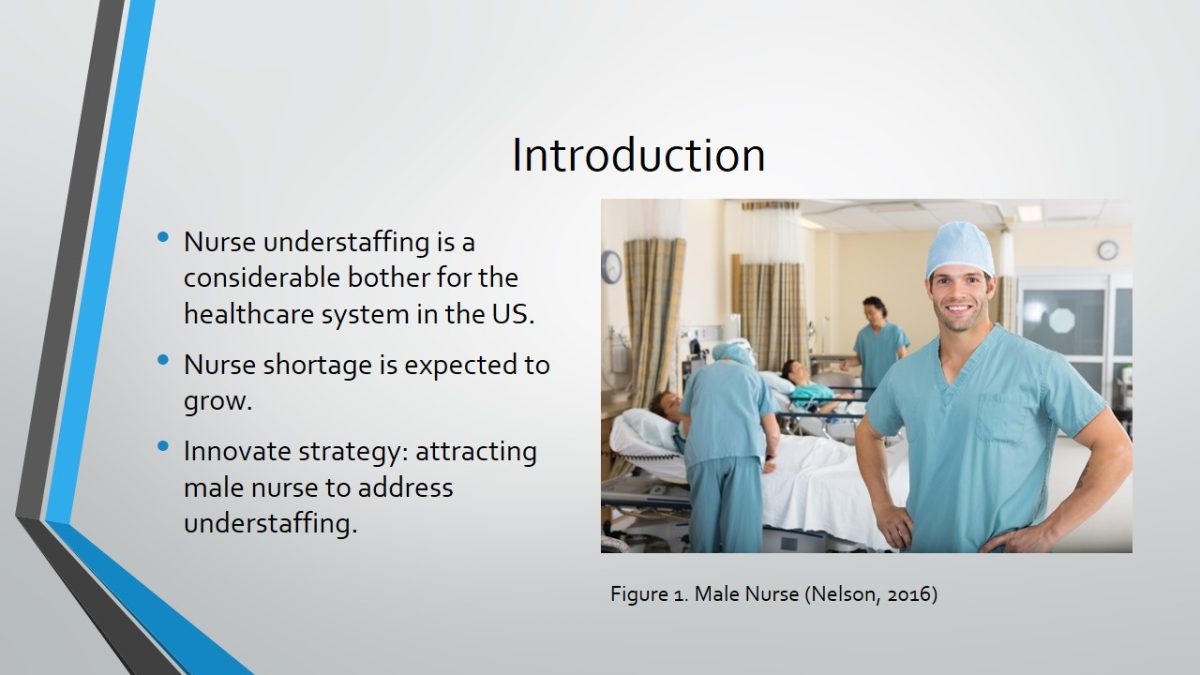
Problem Statement
- Background:
- Nurse shortage is high;
- 1.1 million additional nurses will be needed by 2026(Haddad & Toney-Butler, 2019);
- Nurse understaffing is associated with decreased quality of care (Martin, 2015);
- Only 6.6% of nurses are males.
- Stakeholders:
- Patients;
- Nurses;
- Nurse Leaders;
- Nurse Managers.
The demand for nurses is high and expected to grow since, by 2026, 1.1 million additional nurses will be needed to avoid a shortage (Haddad & Toney-Butler, 2019). The reasons for the issue are numerous, including an aging population, an aging workforce, nurse burnout, and violence in healthcare settings (Haddad & Toney-Butler, 2019). the problem of nurse understaffing may lead to a deterioration in the quality of care (Martin, 2015). Females traditionally dominate the nursing profession, and men in nursing are scarce and believed to be gay or hypersexual (Cottingham, Johnson, & Taylor, 2016).
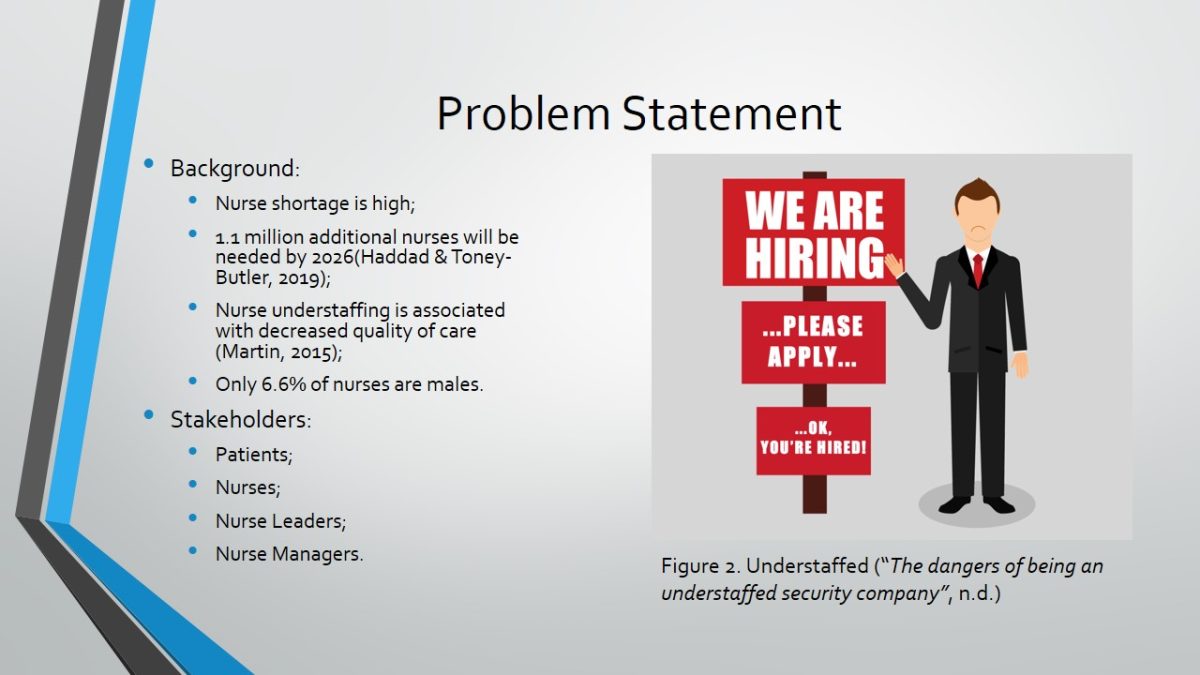
Settings
- The project is based on Eisenhower Medical Center.
- It is a progressive 463-bed hospital that is famous for its reputation as a premier health care facility (Eisenhower Health, n.d.).
- Organizational culture assessment shows that the facility is ready for the proposed change.
The project is based on Eisenhower Medical Center, a a progressive 463-bed hospital that is famous for its reputation as a premier health care facility (Eisenhower Health, n.d.). In order to assess the organizational culture for readiness to change, a questionnaire was elaborated and distributed among healthcare professionals in Eisenhower Medical Center. The list included 12 items with Linkert scale that assessed 10 various aspects of organizational culture. The assessment demonstrates that the hospital is ready for proposed change.
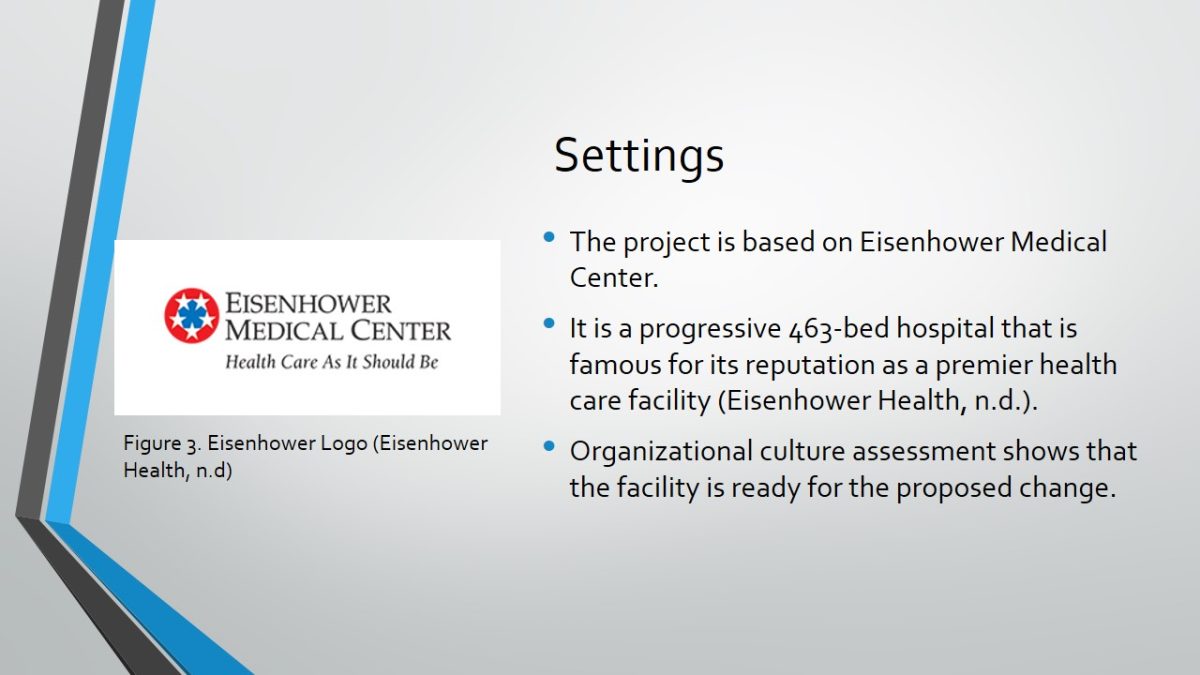
Purpose & Objectives
- Purpose:
- Increase the number of male nurses by 20% in 6 months;
- Improve the staffing situation by 15% in 6 months.
- Objectives:
- Measure the understaffing rate among nurses and the percentage of male nurses at Eisenhower Health;
- Review the available evidence concerning the shortage of nurses and male underrepresentation in the profession;
- Assess the hiring and retention strategies of Eisenhower Health and elaborate a list of suggestions to improve HR practices;
- Implement the proposed plan and evaluate the outcomes by assessing the changes in nurse staffing.
The aim of the proposed change project is to decrease nurse understaffing at Eisenhower Health by adopting male-oriented hiring and retention practices. The purpose and objectives are listed on this slide (read the slide).
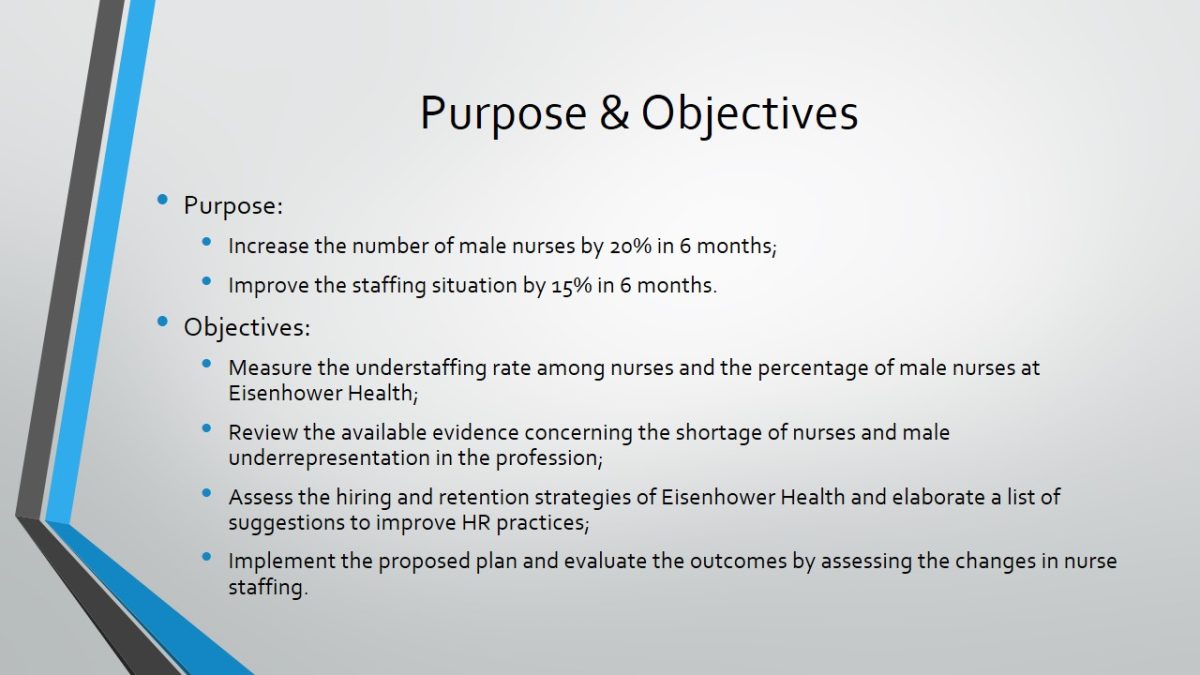
PICOT Question
In outpatient care settings (P), does focusing on male-oriented hiring practices, job satisfaction and retention (I), compared with traditional hiring practices, job satisfaction and retention (C), improve the situation with nurse understaffing and diversification (O) in six months (T)?
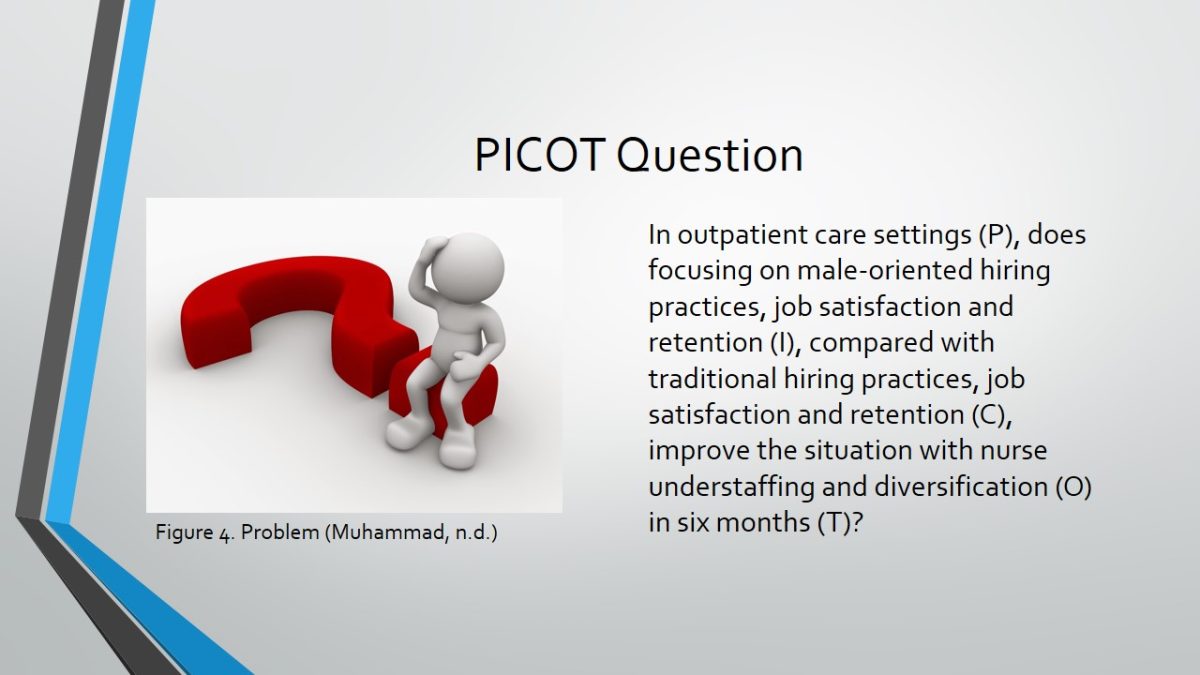
Proposed Solution
- The proposed solution to nursing understaffing is designing and implementing male-oriented hiring practices and retention practices.
- Hiring strategies:
- Advertisements picturing male nurses;
- Focus on stability and career opportunities.
- Retention strategies:
- Creating male role models;
- Zero tolerance to sexism;
- Gender-neutral wording of policies.
The proposed solution to nursing understaffing is designing and implementing male-oriented hiring practices, job satisfaction, and retention. In particular, hiring advertisements should picture more men in the nursing profession (Carrigan & Brooks, 2016). However, these advertisements should avoid emphasizing the masculinity of men to avoid the perception of role incongruity (Clow, Ricciardelli, & Bartfay, 2015). During the interview, the focus will be on career perspectives by presenting nursing as a stable, “flexible and reasonably well-paid job, where specialization and further education is possible” (Yi & Keogh, 2016, p. 103). As for retention practices, male role models will be established by honoring more men as valuable employees, as recommended by Twomey and Meadus (2016). Also, all policies will be revised to make the wording more gender-neutral, and anti-discrimination rules will be emphasized as proposed by Carrigan and Brooks (2016). Since the proposed solution is supported by substantial evidence, it is expected to be successful.
The intervention is also projected to provide positive outcomes since it is realistic and cost-efficient. The implementation costs of the intervention are associated only with the revision of the current documentation and additional training for human resource (HR) managers. Since no special equipment or supplies are required, the expenses will be minimal. Therefore, the intervention is realistic, and no changes are needed to begin the process.
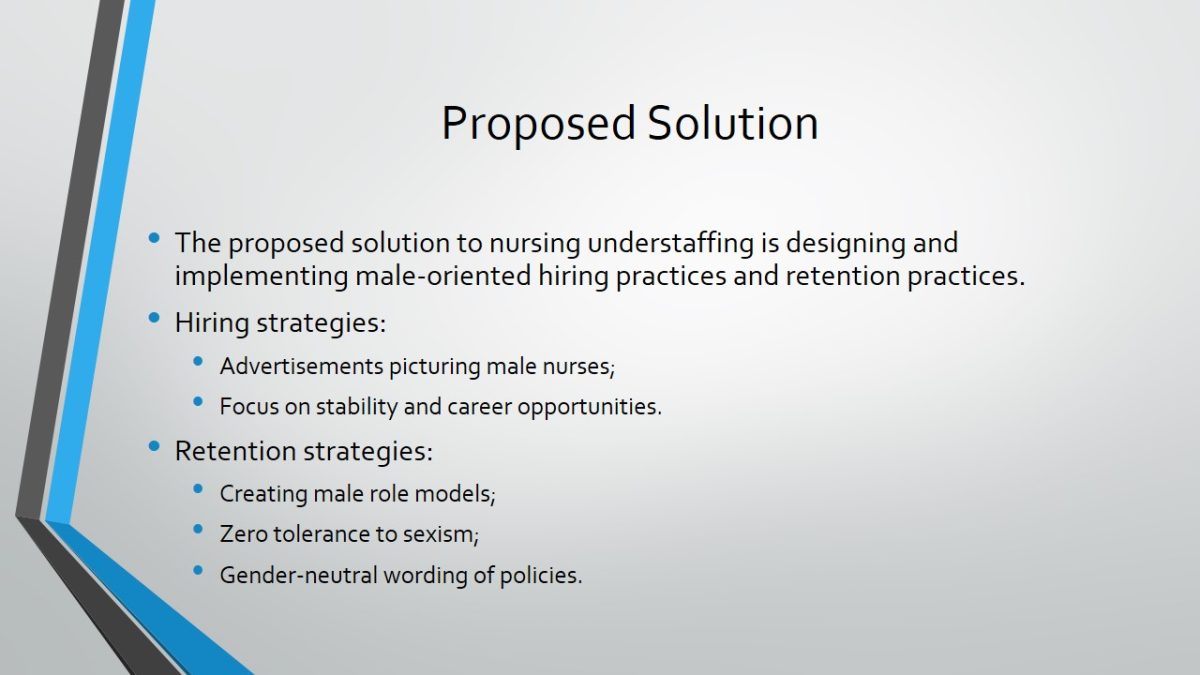
Change Model
- The project uses Roger’s Diffusion of Innovation theory as theoretical framework.
- The theory implies the presence of 4 steps (Lien & Jiang, 2017):
- Spreading awareness;
- Making the decision;
- Initial use;
- Continuous use.
The project uses Diffusion of Innovation theory as theoretical framework; therefore, it has four stages: awareness, decision-making, initial use, and continuous use (Lien & Jiang, 2017). The awareness stage implies that HR managers are to be informed about the problems with the current hiring and retention strategies. For this matter, current practices will be reviewed, and suggestions to improve them will be made. For the second stage, a formal meeting will be organized to discuss the suggestions. The third step includes designing a pilot project to test the effectiveness of proposed solution. The fourth phase, the results will be reviewed and changes to the project will be made to ensure that the prolonged use of the practice will be beneficial for all stakeholders.
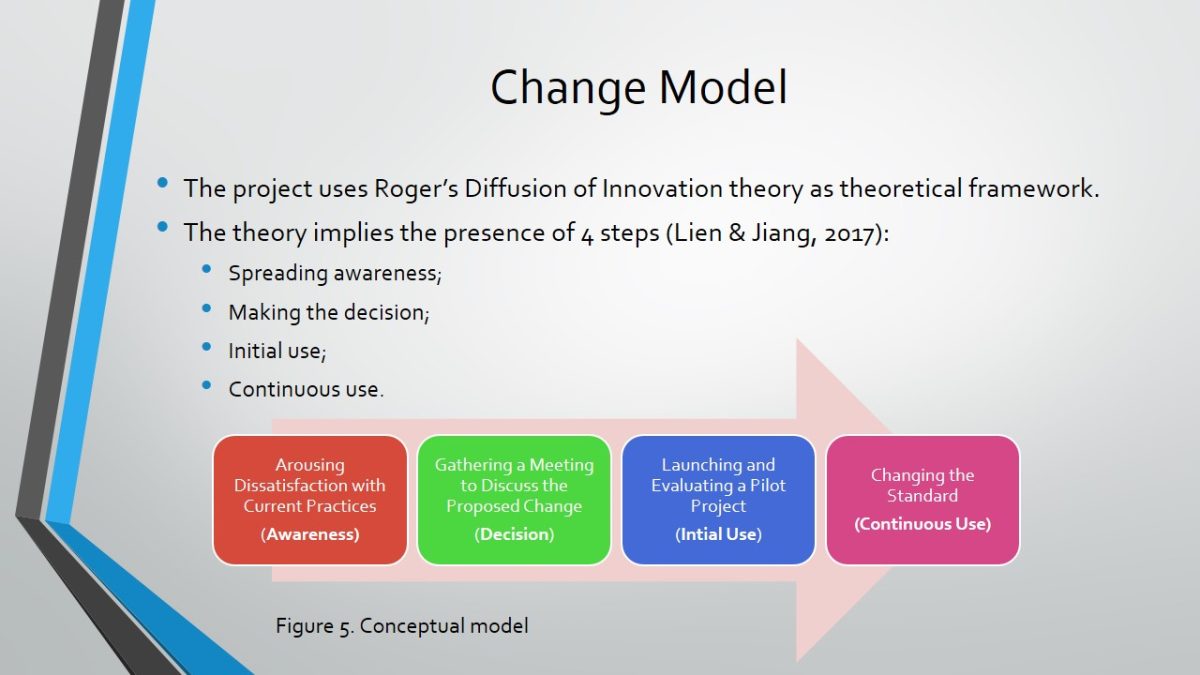
Implementation Plan
- Schedule:
- Review of current practices and understaffing and retention rates (1 week);
- Elaboration of the list of suggestions (1 week);
- Assessment of the recommendations by the HR department (1 week);
- Making the decision (1 day);
- Implementation of changes (6 months);
- Review of the results (1 week);
- Deciding if alterations are needed or if the practice is discontinued (1 day).
- Resources:
- Project manager;
- HR managers;
- Standard office equipment, including computers, printers, and paper.
- Estimated budget – $4000.
The implementation of the project is expected to take 7 months. The plan presented on this slide emphasizes feasibility of the project, since it is cost-efficient and it does not need much resources.

Evaluation and Conclusion
- The success will be measured by juxtaposing staffing situation before and after intervention.
- The reasons for success/failure will be assessed by expert committee.
- In case of negative results the intervention will be revised.
- In case of positive results, the intervention can e replicated to improve validity and generalizability.
The primary method of measuring project success is by comparing the understaffing and retention rates among nurses before and after the intervention. A simple comparison of the numbers will provide clinically relevant information about the effectiveness of the proposed method. Additionally, the reasons for success or failure will be assessed by an expert committee. Even though the method is adequate, it has some evident flaws that need to be stated. The results may be invalid due to the small sample size and insufficient time to test the hypothesis. Additionally, the results will be limited to one healthcare facility and will be inadequate to generalize the implications. In short, the validity of the method may be low due to objective reasons; however, the approach remains valid. In case of negative results, acquired knowledge will be disseminated and the intervention will be modified utilizing the recommendation provided by the expertise. In case of positive results, the project will have significant implications for the nursing practice. An intervention that helps to address the problem of nurse shortage is expected to improve the overall quality of care. As for future research, the change can be easily replicated to solve the issue of low validity.

References
Carrigan, T. M., & Brooks, B. A. (2016). Q: How will we achieve 20% by 2020? A: Men in nursing. Nurse Leader, 14(2), 115-119.
Clow, K. A., Ricciardelli, R., & Bartfay, W. J. (2015). Are you man enough to be a nurse? The impact of ambivalent sexism and role congruity on perceptions of men and women in nursing advertisements. Sex Roles, 72(7-8), 363-376.
Cottingham, M., Johnson, A., & Taylor, T. (2016). Heteronormative labour: Conflicting accountability structures among men in nursing. Gender, Work & Organization, 23(6), 535-550. Web.
Eisenhower Health. (n.d.). About us. Web.
Haddad, L., & Toney-Butler, T. (2019). Nursing Shortage. Web.
Happy senior citizen. (n.d.). Web.
Lien, A., & Jiang, Y. (2017). Integration of diffusion of innovation theory into diabetes care. Journal of Diabetes Investigation, 8(3), 259-260. Web.
Martin, C. J. (2015). The effects of nurse staffing on quality of care. MedSurg Nursing, 24(2), S4-S4.
Muhammad, I. (n.d.) Defining a Data Science problem. Web.
Nei, D., Snyder, L. A., & Litwiller, B. J. (2015). Promoting retention of nurses: a meta-analytic examination of causes of nurse turnover. Health Care Management Review, 40(3), 237-253.
Nelson, L. (2016). Why men should be nurses. Web.
The dangers of being an understaffed security company. (n.d.). Web.
Twomey, J. C., & Meadus, R. (2016). Men nurses in Atlantic Canada: Career choice, barriers, and satisfaction. The Journal of Men’s Studies, 24(1), 78-88.
Yi, M., & Keogh, B. (2016). What motivates men to choose nursing as a profession? A systematic review of qualitative studies. Contemporary Nurse, 52(1), 95-105. Web.